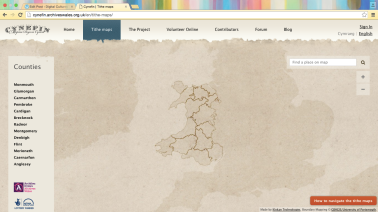Cymru Digidol
On the 15th March, Anthony Mandal and I met with Glen Robson, the Head of Systems at the National Library of Wales, and Owain Roberts, the Acting Head of Research at the National Library of Wales, to learn about the superb digital projects that they are working on over in Aberystwyth. With a focus on projects that have at their core a strong crowd-sourcing element, the following datasets can be defined as being research-led and innovative whilst at the same time allowing for significant public engagement. One of the characteristics of the NLW’s digital work is its user-friendliness and cleanness of design. The work that Glen and Owain are contributing to – both intellectually and practically – has the potential to not only revolutionise how we understand Welsh history but it also has an in-built capacity to engage the general public with how research is conducted (and produced) academically.
Cymru 1900 Wales
www.cymru1900wales.org

Cymru 1900 Wales asks users to transcribe place names from the Ordnance Survey maps of Wales c. 1900. There is currently no software that can collect place names off these maps, so human transcription is necessary. Additionally, the website also asks users to share any special memories they have of the place and any alternative names or spellings that they know may be associated with it. The importance of this project lies in what such data can tell us about social/cultural and historical changes that have occurred in Wales since the start of the 20th Century. As the website says, place names ‘recall agricultural practices and local industries, changed landscapes and lost settlements. They preserve a rich heritage of Welsh-language forms from across the whole country, chart the arrival of English, and illustrate interactions between the two’. The project’s goals recall, to my mind at least, the Irish playwright Brian Friel’s play Translations, which investigates the importance the naming of places has on a small Irish community. Friel observes that, ‘It is not the literal past, the “facts” of history, that shape us, but images of the past embodied in language.’
The site also allows you to overlay a current map onto one of the ordnance survey ones from c. 1900, with fascinating results. I’ve just learnt, for example, that my home in Crickhowell is built on the site of an old reservoir, and that the grounds of the Rectory (still a substantial-sized house on, appropriately, Rectory Road) used to entirely cover what is now the Brynant housing estate. Such information is hugely valuable as it allows us to easily visualise, understand, and question change. As Crickhowell became more secular in the 20th century, did the need for the Church to hold onto such a large amount of land become less important? The overlaying of the two maps, that this site allows, suggests that this is indeed the case. The data collected on the site becomes automatically geolocated and available to use for other digital applications and, already, an astonishing 294345 place names have been transcribed.
Cynefin: The Tithe Maps of Wales
http://cynefin.archiveswales.org.uk/

Similar to Cymru 1900 Wales, but with a key difference: instead of transcribing Ordnance Survey maps, with Cynefin (meaning ‘habitat’) your job is to transcribe tithe maps instead. According to the website, ‘Tithes were payments charged on land users. Originally, payments were made using commodities like crops, wool, milk and stock.’ However, ‘between 1838 and 1850’ tithe maps were produced ‘to ensure that all tithes were paid with money rather than produce.’ The project aims to digitise and repair 1,200 tithe maps by September this year. But, through using crowd-sourcing, the project also aims to transcribe over 30,000 pages of documentation, as well. The ultimate goal of this work is to produce an online resource that will allow anybody to research tithe maps in an effective way.
The website includes a blog and a forum where volunteers can discuss their findings or any problems that they are having with system. According to one blog entry from the end of February this year, volunteers had been transcribing a remarkable 44 pages per day, which accounts for 7631 pages transcribed all together. One of the problems that the volunteers were having was that they were finding it difficult to find the parishes that had not already been transcribed. As a result of this the people running the project implemented a bar chart system that allowed users to simply hover their mouse over any given parish to discover how many pages were left that needed to be transcribed and how many maps remained to be georeferenced.
It is this two way process of communication that I found most impressive with Cynefin. The administrators have built a strong community of transcribers, who openly communicate their thoughts about the project. As something to think about for future crowd-sourcing projects, using Cynefin as a model example, the use of blogs and forums seems to suggest that the key to building a productive online community of volunteers is to provide them with these communication facilities. They even ‘gamify’ the transcription process by awarding scores to the ‘best’ transcribers. With ‘big data’, (and the need to make sense of this data) becoming more and more a location where humanities research is heading, the need to understand how to use crowd-sourcing efficiently and effectively is of paramount concern. It is a concern the Cynefin project has tackled head-on and succeeded in.
Wales at War
www.walesatwar.org

Wales at War is an online resource aimed at schoolchildren. It is designed to ‘engage pupils between the ages of 10 and 14 in historical research by supporting them to create biographies of the names listed on their local war memorial to help reveal the histories of the Welsh men and women who lost their lives during the war’. The site is currently in a ‘closed group testing stage’, so it is difficult to judge the level of activity it is generating, but, nevertheless, it is a hugely exciting and ambitious project; one that I wish had been around when I was in school.
By getting schoolchildren to engage with historical research in this way means that whilst pupils develop the skills that they will later need at university, they also help to produce a highly valuable academic resource. The site is of both pedagogical and research interest. Like Cynefin could be used as a model for crowd-sourcing, Wales at War could, potentially, be used as a model for getting students to engage with research. The site might still be in a ‘testing stage’, but, due to its tremendous design, one can already begin to understand how it will work.
By clicking on the ‘Biography’ menu, the website will bring up a page which lists the names of soldiers, when they were born, the date they died, where they died and where they were from. It is a very moving experience. The first name the website brings up (presumably because this record was the last to be added), is of Ellis Evans, from Penlan, Trawsfynydd who was born in 1887 and died at Ypres on 31/7/1917. He was 29, and if he lived would be 99 today. But that’s not all. Each serviceman also has their own page, where more detail is given about their life. Ellis Evans, it is revealed here, was also a poet, whose bardic name was Hedd Wyn and was posthumously awarded the bardic chair in September 1917. It is worth quoting the record in full:
Ellis Humphrey Evans is perhaps better known by his bardic name, Hedd Wyn. He was a gifted poet and had competed in many local eisteddfodau under the pseudonym HeddWyn. He won his first eisteddfod chair in Bala in 1907. He was posthumously awarded the bardic chair on 6 September at the 1917 National Eisteddfod in Birkenhead, near Liverpool – under the pseudonym ‘Fleur-de-lis’ – following his death in the Third Battle of Ypres (also known as Passchendaele) six weeks previously. The winning awdl (or ode) was called ‘Yr Arwr’, or ‘The Hero’, and was completed while he was serving with the Royal Welch Fusiliers in France. During the ceremony, the empty chair, which was made by a craftsman from Flanders, was draped in a black sheet. The Eisteddfod is now more commonly known as ‘The Eisteddfod of the Black Chair’. The chair still resides at the family home in Yr Ysgwrn, Trawsfynydd.
At the bottom of the page a black cross marks the place where he was killed on Google Maps – Ypres.
Wales at War is truly using digital technology in a remarkable and meaningful way. It is not overly complicated, but it is ambitious. If the project achieves its goals then it really will really be a fitting tribute to all those Welsh men who lost their lives during World War I, and a magnificent digital monument for future generations to explore and value.
Thanks to Glen and Owain for a very stimulating afternoon, we look forward to working with you in the future.
– Michael Goodman
goodmanmj@cardiff.ac.uk
